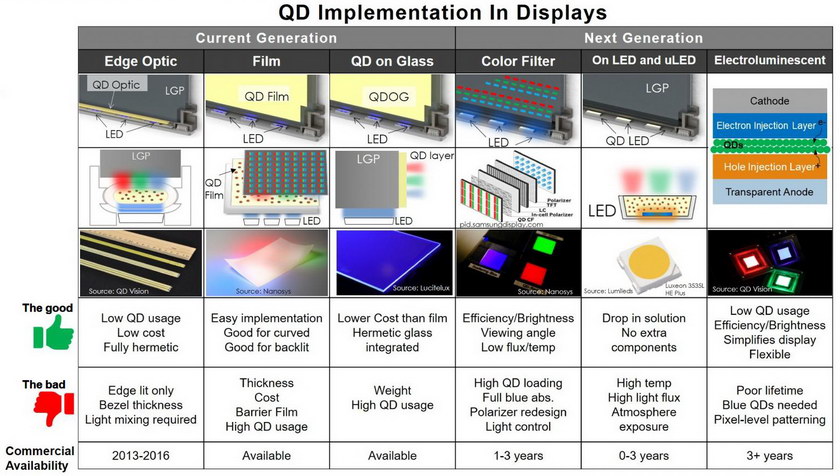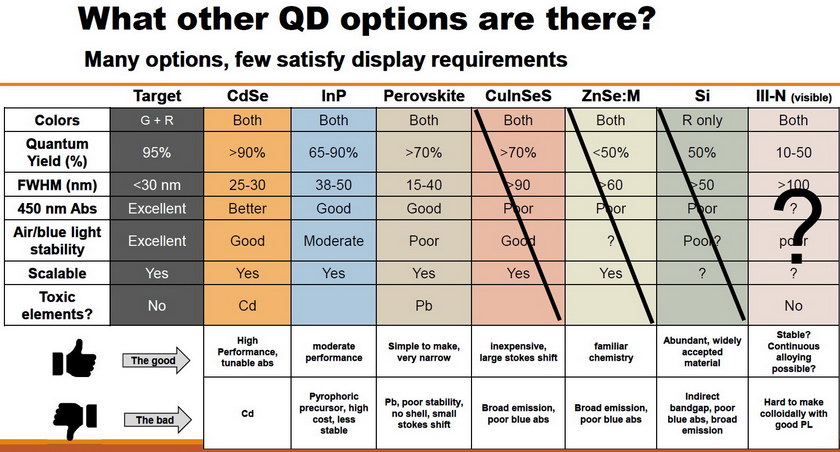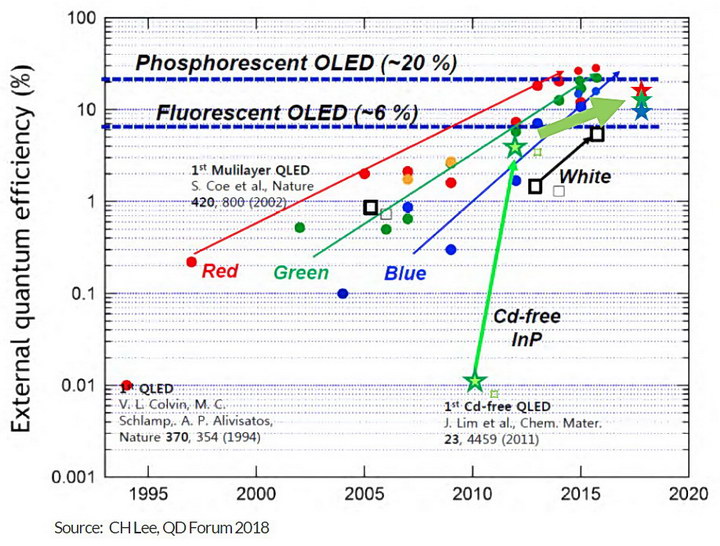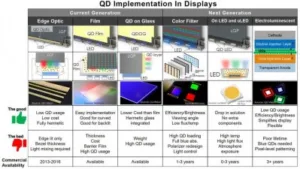There were four papers at the Advanced Display Summit specifically on Quantum Dots (QDs). Since these papers covered relatively familiar ground, I will discuss them only briefly. Several of the papers referred to QD information from SID 2018 and Meko has very extensive coverage of SID (105 pages), including both the QD technical papers and marketing information presented at Display Week.
 Six methods QDs can be used in displays to generate red, green and blue light (Source Palomaki Consulting at ADS)
Six methods QDs can be used in displays to generate red, green and blue light (Source Palomaki Consulting at ADS)
Peter Palomaki of Palomaki Consulting presented the first talk on QDs titled Quantum Dot Display Technology – A Bright Future Ahead. One of the things Palomaki did was discuss six different ways QDs can be used in displays, including the advantages and disadvantages of each approach and the commercial availability. This is summarized in the figure with the three approaches on the left used in current displays and the three on the right expected to be feasible in the future. The electroluminescent technology on the far right is considered the “Holy Grail” of QD display approaches. Essentially, this design would replace the Organic LED materials with the inorganic quantum dots.
 Cadmium-free QD options (Source Palomaki Consulting at ADS)
Cadmium-free QD options (Source Palomaki Consulting at ADS)
Cadmium in displays is a sensitive topic dating back to the use of a cadmium-based green phosphor in CRTs. Cadmium, even in the microscopic quantities used in QDs, is banned under the European RoHS rules, although CdSe QDs currently have a waiver due to the lack of a suitable alternative. This waiver is scheduled to expire in 2020, although it may be extended. In addition, many companies have an aversion to cadmium in their products whether the rules allow it or not. Developing cadmium-free QDs is a major research and development effort today and Palomaki covered six alternatives to CdSe. Three he rejected out of hand, CuInSeS, ZnSe:M and Si. Three other chemistries he considers possibilities – InP, Perovskite and III-N.
One issue that the electroluminescent approach to QD displays would face is the lack of blue quantum dots. In all the other approaches to QD displays, the blue light is produced by blue InGaN LEDs (or, potentially, lasers) and blue QDs are not used. Existing blue QDs have very short lifetimes with demonstrated lives of perhaps 20 hours This is a far cry from the minimum 20,000 hours of life demanded by display manufacturers for components and materials going into their displays. This short life is partly due to the lack of research into blue QDs driven by the lack of demand for them. Whether this is a fundamental property and problem with blue QDs isn’t known (at least by me) at this time.
The second QD paper was given by Shinae Jun, a researcher at Samsung Advanced Institute of Technology (SAIT). It was titled Quantum dot display. This was a surprisingly technical presentation for a venue such as the Advanced Display Summit, complete with references to the Bohr radius of a QD “Atom” and the quantum mechanical Hamiltonian that defines the energy levels of a QD.
 ZnSeS/InP Core/Shell QD design under development at Samsung. (Credit: SAIT at ADS)
ZnSeS/InP Core/Shell QD design under development at Samsung. (Credit: SAIT at ADS)
Jun also discussed the layered nature of QDs, including the cadmium-free ZnSeS/InP structured QD that Samsung is working on that wasn’t on Palomaki’s list of CAD-free QD designs. According to the data she showed, this design has a number of good properties including stability under blue light and a narrow spectral FWHM, leading to a large color gamut. She also discussed the history of QDs at Samsung. They began work on QDs as a research project in 2002 and produced the first CAD-free QD TV in 2015. She said the next research challenges at Samsung will be to produce QD color filters for TV and electroluminescent QD TVs, two advanced QD designs that are on Palomaki’s list.
The next talk was given by Brian Gally from Nanoco and was titled Exploring the future integration modes of quantum dots in mainstream displays. Nanoco has been featured in about 50 LDM/MDM articles since 2016 so I don’t need to go into too much detail about what Gally said. As part of his review of the markets for LCD, QD and OLED displays, he discussed how gamers are demanding high-end displays. One property that is especially important to a gamer is frame rate (HFR). He cited Yole data that said the gaming market for HFR gaming monitors is expected to grow from 2.5m units in 2017 to 5m units in 2021. Currently many of these HFR monitors are in the range from <100Hz to 144Hz but 240Hz is likely to be common in the future. Due to the very fast response of QDs, they may be more suitable for these HFR monitors than phosphors, even if the gamers aren’t really interested in the WCG you get with QDs.
The final QD talk was given by Russell Kempt of Nanosys and was titled The Technology Platform for Future Displays. Nanosys is another company that has had extensive coverage in Meko’s newsletters, with about 55 mentions since 2016. In his introduction to the company he emphasized that Nanosys is the world’s leading Quantum Dot supplier and has shipped over 15 tonnes of Quantum Dots to customers to date.
 EQE of QDs over time (Source: R. Kempt at ADS)
EQE of QDs over time (Source: R. Kempt at ADS)
He said that the commercial requirement for External Quantum Efficiency (EQE) among display makers is commonly about 15%. He added that QDs have exceeded this level and, in some cases, exceeded the approximately 20% EQE produced by Phosphorescent OLED materials.
He also explained about inkjet printing of QDs. He said BOE demonstrated 5” & 14” “AMQLED” devices at SID 2017 made with Nanosys QDS and an inkjet printing process. While the resolution of these systems was very low (80ppi), they were still good enough to earn BOE a “Best in Show” award.
Quantum Dots, like LEDs, produce unpolarized light. At the panel discussion following the four QD presentations, there was a question from the floor about quantum rods, which can, at least in theory, produce polarized light. None of the four speakers had anything useful to say about quantum rods – if their research groups were developing them, they weren’t talking. – Matthew Brennesholtz

